Arm Announces Neoverse N1 & E1 Platforms & CPUs: Enabling A Huge Jump In Infrastructure Performance
by Andrei Frumusanu on February 20, 2019 9:00 AM ESTThe Neoverse E1 CPU: A Small SMT Core for the Data-Plane
We’ve talked a lot about the Neoverse N1 – but today’s announcement actually covers two new platforms. Today actually isn’t the first time that we’ve talked about the other new platform, the new Neoverse E1. Codenamed Helios, the E1 CPU actually is derived from the Cortex-A65AE which we’ve already briefly talked about in December.
Arm largely differentiates between two big workload types in infrastructure deployments, “Compute” use-cases where we need arithmetically capable CPU cores such as the N1, and “Throughput” workloads that largely are mainly about shifting large amounts of data around. The latter category is what the new Neoverse E1 is targeting, representing a specialised CPU core that efficiently and cost effectively is able to handle such tasks.
Arm’s First SMT Core
As some might have read in the Cortex-A65AE announcement piece, the µarchitecture used in Helios both in the Cortex chip as well as in the Neoverse E1 represents Arm’s first ever foray into designing and bringing to market an SMT (simultaneous multi-threading) core. It may at first glance sound a bit weird to have SMT introduced in a smaller CPU core, as traditionally we would be thinking about SMT being useful in raising the back-end execution unit utilisation rate in larger microarchitectures, but it actually makes a lot of sense as well in smaller CPU cores whose workloads are predominantly in the data plane.
In data-processing workloads, cache misses dominate CPU work cycles. This is because we’re talking about data that inherently doesn’t have a long residence time on the CPU core, either streaming from sensors as described in the use-case of the Cortex-A65AE, or in this case streaming from the network in the case of infrastructure workloads. This means that the CPU has to deal with long memory latency accesses, introducing stalls in the CPU pipelines.
The E1 CPU is a small out-of-order design with SMT: In data-plane heavy workloads, introducing the ability to handle a secondary thread on the CPU core essentially represents almost a free throughput gain for the microarchitecture, as it’s able to fill unused execution cycles that otherwise would have just gone to waste. Indeed in optimal workloads, this can result in essentially a doubling of the throughput, on top of the single-threaded microarchitectural gains that the E1 CPU brings over predecessors such as the Cortex A55.
At the cluster level, the Neoverse E1 CPU configuration options are extremely similar to what we’ve seen deployable in DynamIQ systems. The cluster itself looks very much like a DSU, with up to eight cores, a cluster-level snoop filter, and an L3 cache configurable up to 4MB.
The E1 CPU’s Pipelines
The E1’s CPU pipeline actually represents a brand new-design which (besides the A65) haven’t seen employed before. What Arm has done here is take the foundation of what was the in-order Cortex A55 µarch and turned it into a minimally narrow out-of-order CPU. Moving to a basic out-of-order CPU design was essential in order to get more throughput out of the core, as it avoids stalling the whole pipeline in scenarios where we’d have a long load.
The fetch/decode/dispatch stages of the pipeline is 2-wide. In terms of its out-of-order windows, we see a small 40-deep ROB (Re-order buffer).
On the back-end we find a similar execution unit count and layout as on the Cortex-A55. A big difference to the A55 is that the integer ALUs are now differently partitioned: One ALU is dedicated for simple arithmetic operations only, while the second unit now takes over both integer multiplication as well as division tasks, whereas this was divided among the two ALUs in the A55. Interestingly, Arm also demarks the branch port being shared with this second complex integer ALUs, no longer representing it as a dedicated port as on the A55.
The SIMD/Neon pipelines seem to remain the same as on the A55 in terms of its high-level capabilities, but it is possible Arm may have improved cycle latencies of some instructions between the two generations.
Finally, the load and store ports also match the capabilities of the A55.
SMT on the Neoverse E1 is enabled through the duplication of architectural state components of the core. This means the CPU has double the general purpose, vector and system registers and their corresponding structures on the physical core.
At the software level, this naturally simply appears as two separate CPU cores, and can be run at different exception levels or even be running different OSes.
Performance partitioning between the two threads is enabled by a simple round-robin instruction fetch mechanism, ensuing that both threads get the same amount of attention.
The front-end of the CPU has seen improvements in all regards and adopts many of the state-of-the art front end branch prediction and prefetch mechanisms we find in other more recent Arm OoO cores – just in a more limited implementation optimised for the smaller nature of the E1 CPU.
As mentioned just earlier, although the throughput of the execution pipelines hasn’t fundamentally changed, Arm has updated the execution units to employ newer designs with shorter cycle latencies. Here in particular FMAC latency has bene halved, while the integer division unit has been updated to a Radix-16 unit. It’s to be noted that these improvements are again slightly misleading as Arm is making comparisons to the Cortex A53 – the newer Cortex A55 already employed the aforementioned changed, including the new ARMv8.2 double throughput FP16 instructions as well as Int8 dot-products.
On the memory system side of things, we again see very large similarities to the Cortex A55 and the E1 enjoys the same improvements made by that µarch. The only other notable changes here are the fact that the data prefetchers as well as the L2 TLB are now multi-thread aware and are optimised in their design to better operate with the new SMT nature of the core.


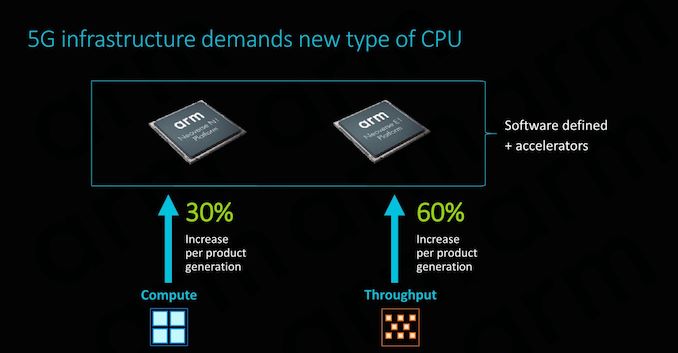
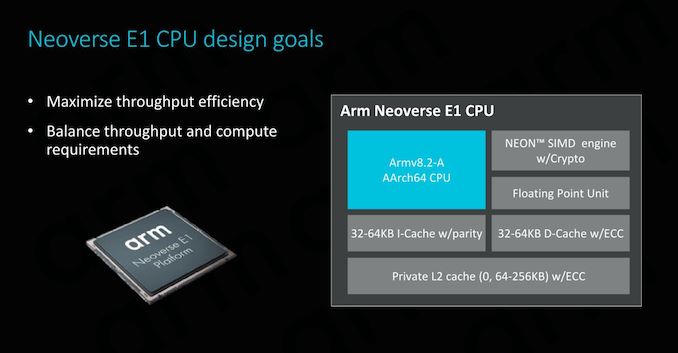
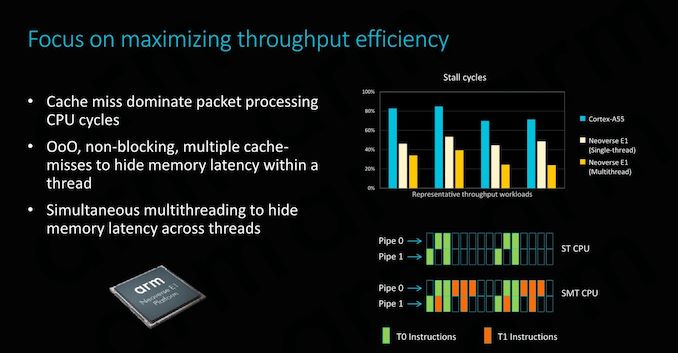
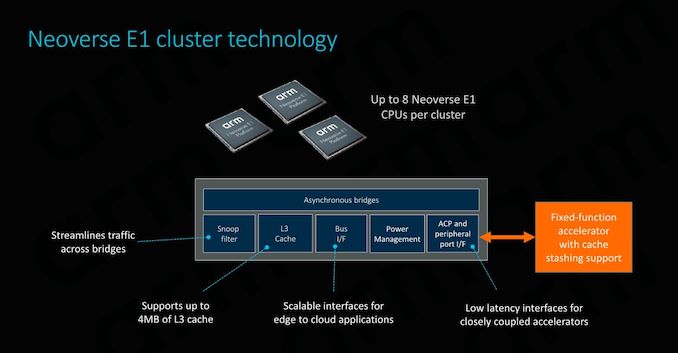
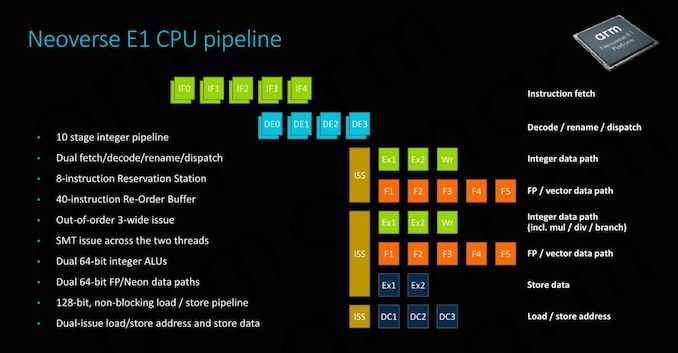
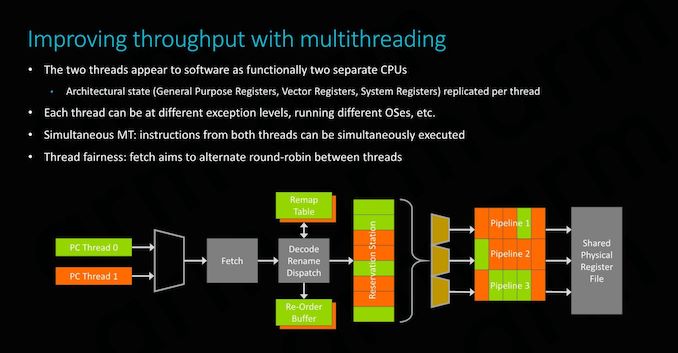
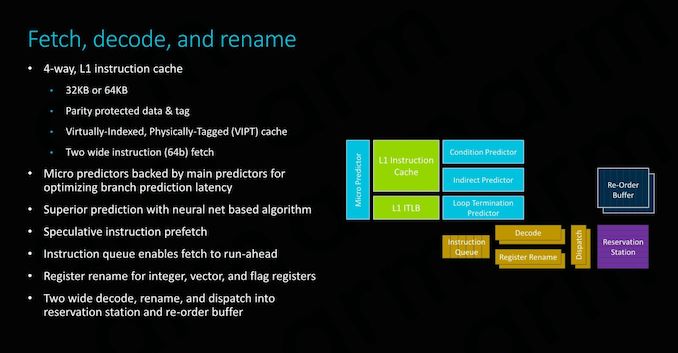
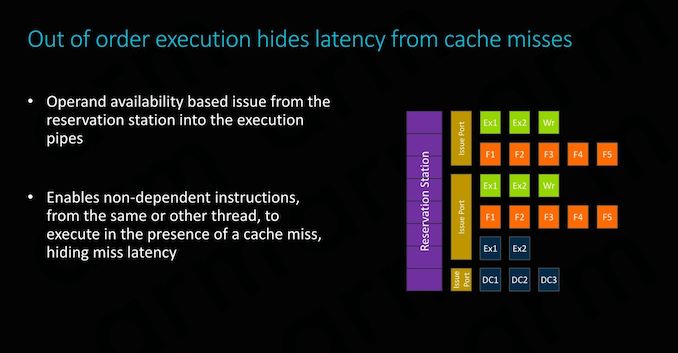

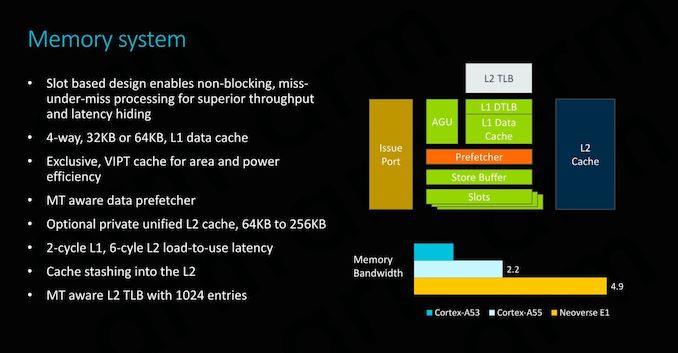








101 Comments
View All Comments
eastcoast_pete - Thursday, February 21, 2019 - link
I stand corrected on IBM still selling x86 servers (they don't), and am actually glad to hear that Power is also used in smaller shops. It's just that I haven't run into too many Power systems around here. It's a very capable arch.Kevin G - Thursday, February 21, 2019 - link
The big Power users are also the big cloud providers. Google and Amazon have reportedly taken a liking to openPower hardware. Facebook has reportedly looking into openPower as well. Granted this are small scale compared to the number of x86 systems these companies have, it was a much need shot of energy into the Power platform.nevcairiel - Wednesday, February 20, 2019 - link
Microsoft already ported Windows Server to ARM, and their entire development stack has support for ARM and ARM64 now, so its only a matter of time for the other server products to be made available.HStewart - Wednesday, February 20, 2019 - link
It really funny that Microsoft did not trust that environment enough to created Surface using ARM processor.GreenReaper - Wednesday, February 20, 2019 - link
Uh . . . that's reportedly because Intel came begging them *not* to for the Surface Go 2018 (and probably cut them a very nice deal on the Pentium Gold as a result): https://www.techradar.com/uk/news/microsoft-surfac...As mentioned, you can also compile for 64-bit ARM in VS now. This is a major win for some apps which truly require native execution (which is not all of them, but enough to be a pain):
https://blogs.windows.com/buildingapps/2018/11/15/...
Will it actually become a viable platform as a result of all this? I suspect it still won't be the default in five years, but in cost-conscious areas it could end up with a foothold. Even if Microsoft doesn't go down that route, it may be open for others to do so for specific purposes, such as education.
eastcoast_pete - Wednesday, February 20, 2019 - link
Not funny; rather, cautious. None of the A76 designs were in silico when MS designed the current Surface. When you specc out a design like the Surface, you base it on what's available at that time, not what might be around next year. Otherwise, the chance of ending up with egg on one's face is uncomfortably high.eastcoast_pete - Wednesday, February 20, 2019 - link
I agree with you, but, as we all know, businesses buy the hardware that can run the software they want or need, not the other way around. In this regard, I am curious if Oracle and SAP are porting their offerings to ARM64 server. If both of those are on board, this design would have a great chance to get strong traction.HStewart - Wednesday, February 20, 2019 - link
One thing that I am concern in this article is that this chip is mark as Simulated in charts which to me is just a marketing term. Also it comparing again existing 2018 designs for both Intel and AMD. An actual fair comparison with Sunny Cove based cpu with more units and such.I also think that just increase cores is not the best way to handle performance, in todays world single core performance is still very important but this depends on the market the chip is intended for but the important part is software compatibility.
Antony Newman - Wednesday, February 20, 2019 - link
H.A Simulated vs Historical point was made in the article. Perhaps you need to reread?
Also : Single Core performance is very important - especially when they are all running flat out.
Intel has to throttle down their multi core beasts so the chips don’t catch fire at 14nm.
At 10nm - Intel will be able to sustain a few more cores before throttling.
And before Intel are at (Intel) 7nm, ARM will likely overtake Intel on the IPC front (assuming that ARM’s ‘prediction is as accurate as my own)
AJ
eastcoast_pete - Wednesday, February 20, 2019 - link
Single core is still important for client computers, but much less so for servers.